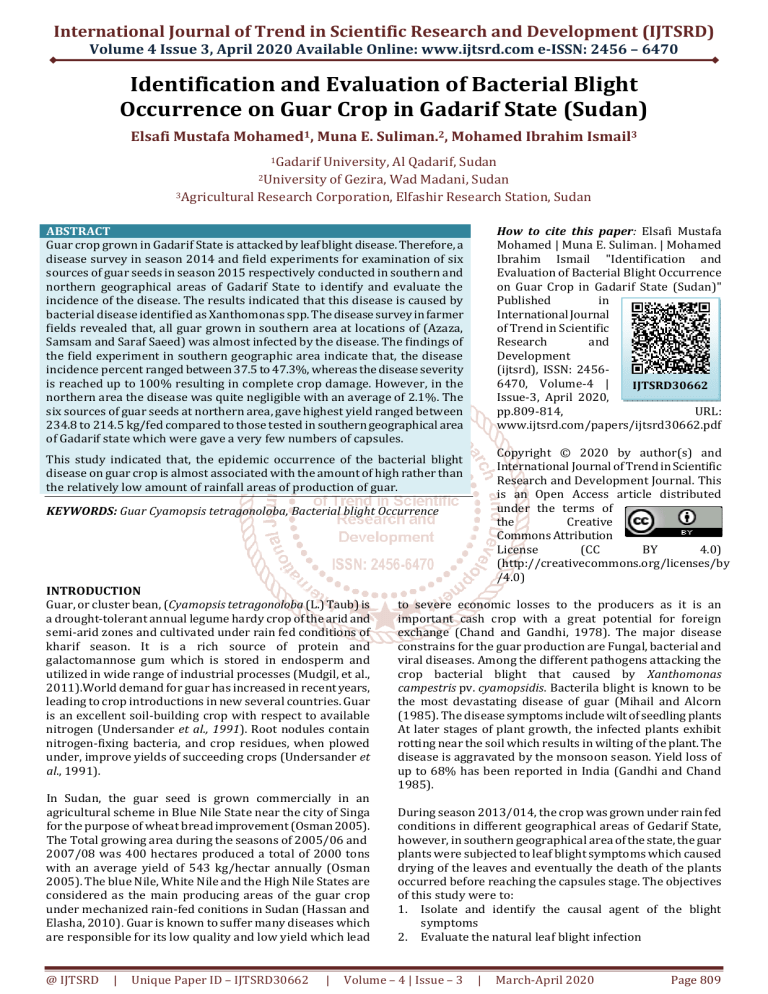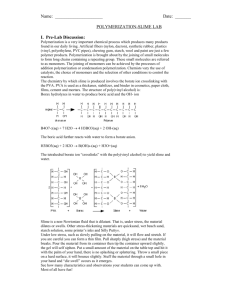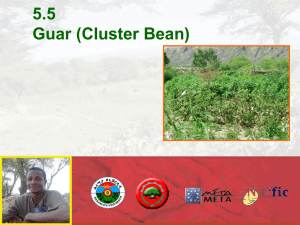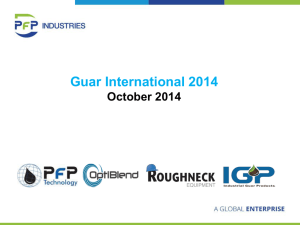
International Journal of Trend in Scientific Research and Development (IJTSRD)
Volume 4 Issue 3, April 2020 Available Online: www.ijtsrd.com e-ISSN: 2456 – 6470
Identification and Evaluation of Bacterial Blight
Occurrence on Guar Crop in Gadarif State (Sudan)
Elsafi Mustafa Mohamed1, Muna E. Suliman.2, Mohamed Ibrahim Ismail3
1Gadarif
University, Al Qadarif, Sudan
of Gezira, Wad Madani, Sudan
3Agricultural Research Corporation, Elfashir Research Station, Sudan
2University
ABSTRACT
Guar crop grown in Gadarif State is attacked by leaf blight disease. Therefore, a
disease survey in season 2014 and field experiments for examination of six
sources of guar seeds in season 2015 respectively conducted in southern and
northern geographical areas of Gadarif State to identify and evaluate the
incidence of the disease. The results indicated that this disease is caused by
bacterial disease identified as Xanthomonas spp. The disease survey in farmer
fields revealed that, all guar grown in southern area at locations of (Azaza,
Samsam and Saraf Saeed) was almost infected by the disease. The findings of
the field experiment in southern geographic area indicate that, the disease
incidence percent ranged between 37.5 to 47.3%, whereas the disease severity
is reached up to 100% resulting in complete crop damage. However, in the
northern area the disease was quite negligible with an average of 2.1%. The
six sources of guar seeds at northern area, gave highest yield ranged between
234.8 to 214.5 kg/fed compared to those tested in southern geographical area
of Gadarif state which were gave a very few numbers of capsules.
How to cite this paper: Elsafi Mustafa
Mohamed | Muna E. Suliman. | Mohamed
Ibrahim Ismail "Identification and
Evaluation of Bacterial Blight Occurrence
on Guar Crop in Gadarif State (Sudan)"
Published
in
International Journal
of Trend in Scientific
Research
and
Development
(ijtsrd), ISSN: 24566470, Volume-4 |
IJTSRD30662
Issue-3, April 2020,
pp.809-814,
URL:
www.ijtsrd.com/papers/ijtsrd30662.pdf
Copyright © 2020 by author(s) and
International Journal of Trend in Scientific
Research and Development Journal. This
is an Open Access article distributed
under the terms of
the
Creative
Commons Attribution
License
(CC
BY
4.0)
(http://creativecommons.org/licenses/by
/4.0)
This study indicated that, the epidemic occurrence of the bacterial blight
disease on guar crop is almost associated with the amount of high rather than
the relatively low amount of rainfall areas of production of guar.
KEYWORDS: Guar Cyamopsis tetragonoloba, Bacterial blight Occurrence
INTRODUCTION
Guar, or cluster bean, (Cyamopsis tetragonoloba (L.) Taub) is
a drought-tolerant annual legume hardy crop of the arid and
semi-arid zones and cultivated under rain fed conditions of
kharif season. It is a rich source of protein and
galactomannose gum which is stored in endosperm and
utilized in wide range of industrial processes (Mudgil, et al.,
2011).World demand for guar has increased in recent years,
leading to crop introductions in new several countries. Guar
is an excellent soil-building crop with respect to available
nitrogen (Undersander et al., 1991). Root nodules contain
nitrogen-fixing bacteria, and crop residues, when plowed
under, improve yields of succeeding crops (Undersander et
al., 1991).
In Sudan, the guar seed is grown commercially in an
agricultural scheme in Blue Nile State near the city of Singa
for the purpose of wheat bread improvement (Osman 2005).
The Total growing area during the seasons of 2005/06 and
2007/08 was 400 hectares produced a total of 2000 tons
with an average yield of 543 kg/hectar annually (Osman
2005). The blue Nile, White Nile and the High Nile States are
considered as the main producing areas of the guar crop
under mechanized rain-fed conitions in Sudan (Hassan and
Elasha, 2010). Guar is known to suffer many diseases which
are responsible for its low quality and low yield which lead
@ IJTSRD
|
Unique Paper ID – IJTSRD30662
|
to severe economic losses to the producers as it is an
important cash crop with a great potential for foreign
exchange (Chand and Gandhi, 1978). The major disease
constrains for the guar production are Fungal, bacterial and
viral diseases. Among the different pathogens attacking the
crop bacterial blight that caused by Xanthomonas
campestris pv. cyamopsidis. Bacterila blight is known to be
the most devastating disease of guar (Mihail and Alcorn
(1985). The disease symptoms include wilt of seedling plants
At later stages of plant growth, the infected plants exhibit
rotting near the soil which results in wilting of the plant. The
disease is aggravated by the monsoon season. Yield loss of
up to 68% has been reported in India (Gandhi and Chand
1985).
During season 2013/014, the crop was grown under rain fed
conditions in different geographical areas of Gedarif State,
however, in southern geographical area of the state, the guar
plants were subjected to leaf blight symptoms which caused
drying of the leaves and eventually the death of the plants
occurred before reaching the capsules stage. The objectives
of this study were to:
1. Isolate and identify the causal agent of the blight
symptoms
2. Evaluate the natural leaf blight infection
Volume – 4 | Issue – 3
|
March-April 2020
Page 809
International Journal of Trend in Scientific Research and Development (IJTSRD) @ www.ijtsrd.com eISSN: 2456-6470
Recognize the factors enhance the intensity of the
disease
Effect of disease on the crop yield.
tillage was practiced and direct seeding was done mid-July.
Weeding was done when necessary throughout the growing
period. No disease control was implemented.
Materials and Methods
Disease survey in guar farmers fields in Gadarif sate:
Disease survey was carried out during season
2014/2015/2016 in fields grown with guar crop in different
geographical areas of Gadarif State, These areas were, Azaza,
Saraf saaed, Sumsum (southern geographical area),
Elfashaga (eastern geographical area), Gadarif research farm
and Elmegreh (northern geographical areas of Gadarif State).
The map on plate no (1) shows locations of those areas. The
surveyed fields were randomly chosen according to a
specified driving distance. Also data of rainfall of the
surveyed area had been taken (Tables 5).
Incidence assessment of disease on the crop was done at the
time symptoms started to develop on the leaves. Disease
severity was scored using 1 – 5 disease scoring scale where,1
represented 0 % infection and 5 represented over 75 %
infection, according to Ishii et al., (2001), (table 4). Hand
harvesting of the capsules (pods) was done and the seeds
were threshed and weighed after drying for yield purposes.
3.
4.
In each surveyed guar field, the incidence of the disease was
assessed from ten random spots along the diagonal of the
field. In each spot, the disease was assessed in a 1 m2 area
and the percent incidence of each disease was determined as
a percentage according to the following formula (Ishii et al.,
2001):
Disease incidence (%) = No. of infected plants
Total No. of plants inspected x 100
Description of the blight symptoms occurred on guar:
Initial field symptoms included water-soaked spots on
leaves, at the later stages of disease infection, the color of the
spots became dark. Also large, angular, necrotic lesions at
leaf tips, black streaks on petioles and stems, split stems,
defoliation, wilting or top withering, and dieback were
among the observed symptoms (Plates 2 - 5 ).
Isolation and identification of the causal agent from
infected guar leaves:
Isolation of the pathogen from infected guar leaves was
conducted at Plant Pathology Laboratory, faculty of
agricultural sciences at University of Gezira. Samples of
diseased leaves and stems were surface sterilized using
sodium hypochlorite 70% and then plated on nutrient agar
medium culture (NA). Plates were then incubated at 28°C for
72 h. Gram staining and Potassium hydroxide test (KOH test)
were used for the identification of the pathogen. Pathogen
was aseptically removed from Petri plates with a tooth pick
or an inoculating wire loop, placed on glass slide in a drop of
3% KOH solution, stirred for 5-8 seconds and observed for
the formation of slime threads (Suslow, 1982, Schaad et al.,
2006).
Field experiments:
Six seed samples of unidentified guar cultivars were used in
the field trials in season 2016. Two field experiments were
conducted at southern and northern geographical areas
under natural rain-fed conditions. The field experiment was
laid out in a randomized complete block design (RCBD) with
6 samples randomly allocated in 4 blocks, so that each
sample appeared once in every block. The entire field area
was (546 m²). Each plot had 4 rows of guar (0.8 m) apart and
each row is (5m) long, with an area of (9 m²). One-meter
spacing was maintained between plots and (2 m) between
blocks. The border rows consisted of the 2 outer rows and
(50 cm) on either of the remaining sides of the plot.
Therefore, the net plot assessed was (2.4 m.) Minimum
@ IJTSRD
|
Unique Paper ID – IJTSRD30662
|
Results and Discussion
Incidence of disease on guar in farmer fields during the
survey at different areas of Gadarif Sate:
Results of fields disease survey revealed that, occurrence of
the bacterial leaf blight on the guar grown in the southern
geographical area at locations of Azaza, Samsam and Saraf
Saeed showed more disease intensity compared to the guar
grown in the eastern at Elfashaga location and in the
northern area at location of Elmegrih and ARC Farm. (table
1). The incidence of the disease in fields of the southern
geographical area ranged between 44.3 and 39.7% with an
average of 42.6% whereas in eastern and northern
geographical areas the disease incidence was quite negligible
ranged between 0.0-1.6 percent with an average of 0.6%.
Guar fields in the southern regions of Gadarif had higher
disease incidence as compared to guar fields in the eastern
and northern regions of Gadarif and no disease incidence
was detected on Gadarif Research farm (FHG-53).
Isolation of the disease:
Isolation of the disease from infected guar leaves showed
typical yellowing characteristic features of Xanthomonas spp.
on Nutrient Agar Medium Plates (6) and Table (2) shows
bacterial characteristics.
Identification of the disease:
Isolates that were tested and found gram –negative by gram
staining technique gave a positive with KOH test. Slime
threads were formed when bacterial cultures were mixed
with 3% KOH solution. Formation of slime threads, the
mixture become viscous, string out, all these features is an
indication of being gram negative, (plate 7).
The causal of this infection is a bacterial blight disease as
indicated by the visual symptoms and the identification of
the isolated bacterium from the infected plants. The disease
outbreak occurred in the southern geographical region of
Gadarif State before flowering stage after heavy rains
(925.1mm) causing severe foliar defoliation and resulting in
complete crop yield failure.
Field experiments
Incidence and severity of bacterial leaf blight disease:
As shown in table 3, the incidence of the disease on the guar
cultivars tested in the southern geographical area ranged
between 37.5 and 47.3% with an average of 41.2%, whereas
in northern geographical area the disease was quite
negligible since it was recorded very low percentages of
incidence ranged between 1.5 and 2.7% with an average of
2.1%. Also they showed very severe bacterial blight disease
infection up 90 to 100% as black streaks on stems in the
southern geographical area. However, the black streaks were
not observed on stems of the same tested sources of guar
seed in northern Gadarif area.
Volume – 4 | Issue – 3
|
March-April 2020
Page 810
International Journal of Trend in Scientific Research and Development (IJTSRD) @ www.ijtsrd.com eISSN: 2456-6470
The higher occurrence percent of the bacterial disease
incidence on the guar in the southern area of Gadarif State
may be attributed to the wet inductive climatic conditions
caused by the higher amount of the rainfall (table 4). High
rainfall act as the main conducive factor for disease
development since. severity of the infection in southern area
of Gadarif was up to 100%. These findings agree with Mihail
and Alcorn (1985) who reported the occurrence of a high
incidence of bacterial blight of guar in Arizona State after
rainfall. Also, Ren et al. (2014) noticed the dependence of
bacterial disease development in guar on frequent rains
Unlike the southern area, the disease incidence at the
northern area of Gadarif State was negligible . No defoliation
or death of plants had occurred and this due to the
insufficient favorable conditions with relatively low amount
of rainfall to induce epidemic infection by this disease.
Effect of Bacterial blight on yield of guar:
The results in Table (5) showed that no significant
differences (at p 0.5) in seed yield among the six tested
samples of guar in northern geographical area and gave
significant higher yield ranged between (234.8 to 214.5 kg/
feddan) compared to those tested in southern geographical
area of Gadarif state which were gave a very few and
uncountable numbers of capsules. Yield loss of up to 68%
has been reported in India (Gandhi & Chand 1985).
Thus, the study indicates that the epidemic occurrence of
bacterial blight disease on guar crop is almost associated
with the amount of high rather than the relatively low
amount of rainfall areas of guar crop production.
Conclusions
1- Bacterial blight is important disease of guar crop in
Gadarif State.
2- The disease is closely associated with the areas under
high rainfall conditions
2- Guar crop was highly susceptible to the disease in
southern Gadarif area.
5- Guar crop was most resistant to the disease in northern
geographical area of the State.
6- For the time being, the northern is the most suitable
area for production of the crop.
Plate1. Map shows the surveyed areas in Gadarif state (production zones), carried out during season 2015/2016
Plate2. General field symptoms of the disease on Guar crop during field survey, August, 2015.
@ IJTSRD
|
Unique Paper ID – IJTSRD30662
|
Volume – 4 | Issue – 3
|
March-April 2020
Page 811
International Journal of Trend in Scientific Research and Development (IJTSRD) @ www.ijtsrd.com eISSN: 2456-6470
Plate3. Symptoms development of bacterial leaf blight on true leaves of Guar
Plate4. Symptoms of the bacterial leaf blight disease on stems of Guar
Plate5. Disease progress (severity) appeared as black streaks and death on leaves and stem of guar.
Plate6. Morphological characters of colonies of bacterial blight disease, grown on NA medium
Plate7. KOH string test shows the formation of the slime threads on the loop that immerged on the mixer of the
tested bacterial colony and a drop of KOH solution on a glass slide.
@ IJTSRD
|
Unique Paper ID – IJTSRD30662
|
Volume – 4 | Issue – 3
|
March-April 2020
Page 812
International Journal of Trend in Scientific Research and Development (IJTSRD) @ www.ijtsrd.com eISSN: 2456-6470
Table1. Diseas incidence percent on guar in farmer fields at different geographical areas of Gadarif Sate
2015/2016.
Southern area
Eastern area
Northern area
Disease
Azaza Samsam Saraf Saeed
Elfashaga
Elmegrih ARC Farm
Bacterial leaf blight
44.3
39.7
43.8
1.6
1.3
0.0
Mean
42.6
1.6
0.6
The variety grown in farmers fields were local type, whereas in Gadarif Research farm they grew the guar variety (FHG-53).
Table2. Morphological characterization of the bacterium grown on nutrient agar medium after 72 hrs
No
Morphology
Source of inoculums Leaves
1
colony form
Circular convex
2
colony color
pale yellow
3
4
5
6
Colony surface
Shape
Colony elevation
Colony margin
Smooth mucoid
Rod shape
Raised
Entire
Table3. Mean disease incidence percent and severity of bacterial blight disease on guar in northern and southern
Gadarif area (season 2016/2017)
Source of guar seed
Northern Gadarif area Southern Gadarif area
Gylani/azaza
Medrak/Sarafsaeed
Zeraa/sumsum
Yassir/Elfashaga
Kamal/Elmegrih
% Incidence
2.7
1.8
2.5
1.7
2.6
Severity
0.0
0.0
0.0
0.0
0.0
% Incidence
47.3
37.5
40.7
43.1
41.0
Severity
98.6*
98.6
90.8
99.3
99.6
1.5
2.1
0.0
0.0
37.6
41.2
100
97.8
Research farm(FHG-53)
Mean
*: > 75 % infection (scale 1 – 5)
Table4. Monthly and total rainfall for northern and southern parts of Gadarif State in seasons (2015/016
and2016/017) respectively
Rainfall (mm)
Month
Southern Gadarif Northern Gadarif
May
59.0
0.0
46.2
1.8
June
41.0
3.7
25.1
28.6
July
August
September
October
Total
160.8
417.3
126.0
121.0
925.1
188.4
106.1
158.5
153.5
950.7
51.7
173.3
58.3
35.6
390.2
38.5
223.1
298.2
121.0
610.2
Table5. Effect of Bacterial blight disease on yield of guar crop (season 2016)
Northern Gadarif area
Southern Gadarif area
Source of guar seed
Yield (seeds kg/fed)
Yield (capsules/sub plot)
Gylani/Azaza
217.8
54.7
Medrak/Sarafsaeed
216.6
62.5
Zeraa/Sumsum
217.9
26.4
Yassir/Elfashaga
234.8
117
Kamal/Elmegrih
214.5
24.3
Research farm (FHG-53)
219.3
27.1
CV %
10.3 -SE +
7.04 -LSD +
21.1 --
@ IJTSRD
|
Unique Paper ID – IJTSRD30662
|
Volume – 4 | Issue – 3
|
March-April 2020
Page 813
International Journal of Trend in Scientific Research and Development (IJTSRD) @ www.ijtsrd.com eISSN: 2456-6470
References
[1] Chand JN and Gandhi SK (1978). Diseases of guar and
their control. Forage Research 4A 49-66.
[7] Mudgil, D.; Barak, S.; Khatkar, B. S. (2011). "Guar gum:
Processing, properties and food applications—A
Review". Journal of Food Science and Technology.
[2] Elsafi, M., M. (2013). A survey of disease in guar in
Gadarif State. Plant Pathology Annual Report, Gedarif
Research Station, Agricultural Research Corporation.
Sudan.
[8] Osman. M. E. (2005). Performance of Guar as a new
crop under food irrigation in Gash Dulta. In: Proceeding
of the National Crop Husbandry Committee, Elsiddig, K
(ed.) pp. 73-76, ARC, Wad Medani, Sudan.
[3] Gandhi, S. K. and Chand, J.A. (1985). Yield losses in guar
due to bacterial blight caused by Xanthomonas
campestris pv. cyamopsidis. Indian Phytopathology 38:
516-519.
[9] Ren, Y. Z., Y. L. Yue, G. X. Jin and Q. Du, 2014. First
Report of Bacterial Blight of Guar Caused by
Xanthomonas axonopodis pv. cyamopsidis in China.
Phytopathology, 98(6): 840.2- 840.2.
[4] Hassan, A. E. and Elasha, A. E., 2010. Crop Production
Under Mechanized Rain-fed Agricultural in Sudan. In:
Proceeding of the National Symposium on Sustainable
Rain-fed Agricultural in Sudan. 17-18 November 2009,
Al Shariga Hall, University of Khartoum, Sudan.
Mustafa, M. A. (eds.) UNESCO Chair of Desertification
Studies, University of Khartoum, Sudan. pp. 89-112.
[10] Schaad, N. W., Postnikova, E., Lacy, G., Sechler, A.,
Agarkova, I. V., Stromberg, P. E., Stromberg, V. K., and
Vidaver, A. M. 2006. Emended classification of
Xanthomonas.
[5] Ishii, H., B. A. Fraaije, T. Sugiyama, K. Noguchi, K.
Nishimura, T. Takeda, T. Amano, and D.W. Hollomon.
(2001). Occurrence and molecular characterization of
Strobilurin resistance in cucumber powdery mildew
and downy mildew. Phytopathology 91:1166–1171.
[6] Mihail, J. D. and Alcorn, S. M. (1985). Bacterial blight
(Xanthomonas campestris pv. cyamopsidis) of guar in
Arizona. Plant Disease (Abstr.). 69: 811.
@ IJTSRD
|
Unique Paper ID – IJTSRD30662
|
[11] Suslow T.V (1982). Application of a rapid method for
Gram differentiation of plant pathogenic and
saprophytic bacteria without staining .phytopathology.
72:9117-918.
[12] Undersander D. J., Putnam D. H., Kaminski A. R., Doll
J.D., Oblinger E. S. and Gunsolus J. L. 1991. Guar.
University of Wisconsin-Madison, University of
Minnesota [1] Accessed November 8, 2012.
[13] Watson, D. R. W. (1970). Bean common blight and
Fuscous blight in New Zealand garden pea seed stocks.
Pl. Dis. Reptr. 54: 1068 – 1072.
Volume – 4 | Issue – 3
|
March-April 2020
Page 814





